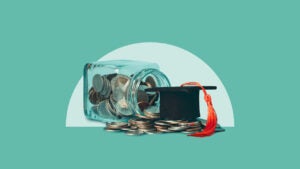What is student loan default? Millions of federal loan borrowers are finding out




Key takeaways
- A defaulted student loan happens when you don’t make payments on your student loan, often for a few months or more.
- Having a student loan in default can mean serious consequences, including poor credit, the loan payments becoming due in full immediately, the lender taking you to court and not being eligible for forbearance or deferment.
- To avoid the worst consequences, consider federal student loan rehabilitation or consolidation, or negotiate a private student loan settlement.
Student loan default occurs when you fail to pay your loans according to the terms of your loan agreement. The exact timeline varies depending on whether you have federal or private loans. Defaulting on your loans can mean major financial and credit score headaches.
For instance, on May 5, the Trump Administration’s Department of Education resumed debt collections on federal loans. A federal loan officially enters default when it’s 270 days past due. Defaulting has serious consequences, including credit damage, wage garnishment and losing federal student laon benefits.
About 5.3 million defaulted federal loan borrowers could be joined by another 5 million by summer’s end, according to the Department of Education.
“Let me tell you this: 90 percent of those people that are going to be declared to be in default … are willing and ready and willing to pay,” former Federal Student Aid chief operating officer A. Wayne Johnson said at a mid-May higher education financing conference. “Right now, they don’t know how, they can’t, they’ve been told to call up your servicers, [but] wait times are six to ten hours.”
Johnson added later: “The biggest crisis — I’m a broken record on this — of this very moment in time is how is the Department of Education going to deal with the accounts going into default.”
Fortunately, there are ways to deal with defaulted federal and privately held education debt, including rehabilitation or consolidation (federal) and refinancing or settlement (private). Asking for help goes a long way, too.
How do you go into default on a student loan?
When you miss your due date, your loan first becomes delinquent. It will remain that way until you pay the amount you owe, qualify for deferment or forbearance, change your repayment plan or enter default.
Once your loan payment is 90 days late, your student loan servicer will report your delinquency to the three credit bureaus — Experian, Equifax and TransUnion.
At that point, your loan will transition from delinquency to default on a timeline that depends on the type of loans you have.
- With federal student loans, your loan is usually considered in default when you don’t make your scheduled payments for 270 days. One exception is Perkins Loans, which can be considered default if you miss a single payment.
- With private student loans, you’re usually considered in default after you miss three monthly payments or 90 days total.

We’re facing a student loan default crisis. This academic research might help
How a timely "nudge" from the federal government could prevent tens of thousands of credit-harming delinquencies.
Learn moreHow do I know if my student loans are in default?
If your student loans become delinquent or past due, your lender or servicer will likely notify you. You may receive a notice in the mail, a call from your servicer or an email with details on your late payment. (This is one reason it’s critical to confirm that your creditors have your updated contact information.)
Once your loans enter default, you should see them listed on your credit reports. You can get free weekly credit reports from the three credit bureaus using AnnualCreditReport.com.
You can also log into the Federal Student Aid website to see the status of your federal loans, including any information on past-due, delinquent or defaulted amounts. Your private lender’s website or portal should have similar information for your private loans.
Predatory actors tend to target the most vulnerable borrowers. If someone you don’t know reaches out to you promising “immediate” or “fast” assistance in exchange for a fee, that’s a red flag. Remember that student loan default remedies are free and can be undertaken by you, the borrower. One helpful rule to follow: If someone you don’t know calls you, tell them you’ll dial your lender or federal loan servicer directly to confirm.
What happens if I default on my student loans?
You could face multiple consequences if your loan enters default.
- Credit approval becomes difficult: Default hurts your credit score. So, it also hurts your ability to get approved for anything involving a soft or hard credit check. You might have trouble getting a credit card, a car loan, a mortgage, a cell phone, utilities or affordable homeowners insurance rates. You’ll likely face higher rates or need a co-signer.
- You owe the entire balance immediately: With federal loans, your entire unpaid balance and owed interest become immediately due through a process called “acceleration.”
- You lose borrower protections and access to federal aid: Your federal loans will no longer be eligible for deferment or forbearance, nor can you change your repayment plan. You won’t be able to access additional federal student aid (if you’re still in or go back to school), either.
- You might be sued: Your federal or private loan servicer can take you to court. In addition, you will likely be on the hook for court costs, collection fees, attorney fees and additional expenses associated with the collection process.
- You could forfeit wages or federal benefits: Your wages could be garnished, and “Uncle Sam” could seize your federal tax refund or Social Security benefits. Fortunately, there are strategies for protecting your wages from garnishment.
- Your academic transcript may be withheld: Your school may withhold your academic transcript until you get your loans out of default. However, note that schools aren’t allowed to withhold your transcript over defaulted-on federal loans.
While all of this takes place, late fees and interest will continue to accrue on your debts, meaning the problem only gets worse.
If you’re concerned that you may default or are having financial challenges, do not ignore the issue. Reach out to your federal loan servicer proactively and find out about your options for avoiding default. However, if you have privately-held education debt in default, keep student loan statute of limitations before you proceed.
How do I get my student loans out of default?
In addition to understanding student loan default, it’s important to know how to turn the situation around. If you’ve already defaulted, there are ways to get back in good standing.
Getting federal student loans out of default
There are three main ways to get your federal loans out of default: paying your entire loan balance in full, pursuing loan rehabilitation or applying for loan consolidation via the Education Department. Since most people can’t afford to pay their loans off in one big chunk, rehabilitation and consolidation are the only options most can consider.
Federal loan rehabilitation
When you rehabilitate a federal Direct Loan or FFEL loan, you must:
- Contact your federal loan servicer to confirm your eligibility.
- Make nine affordable monthly payments (as determined by your loan holder) within 20 days of the due date and agree to these terms in writing.
- Make all nine of the agreed-upon payments during a period of 10 consecutive months.
The monthly payment you make under loan rehabilitation typically equals 10 or 15 percent of your monthly discretionary income. According to the Department of Education, discretionary income is “the difference between your annual income and 150 percent of the poverty guideline for your family size and state of residence.”
Your monthly payment during the rehabilitation process could be as low as $5. After you complete rehabilitation, the record of default will be removed from your credit history (though late payments will remain).
The Senate’s version of conservative Congress members’ “Big, Beautiful Bill” would change the minimum monthly amount due during rehabilitation to $10 per month. However, it would allow federal loan borrowers to utilize rehabilitation twice over the life of their loans, not just once, as is the case under current rules.
Consolidation
With federal student loan consolidation, you combine your existing federal student loans into one new one. To qualify for this plan for defaulted loans, you must do one of the following:
- Agree to enroll your new Direct Consolidation Loan in an income-driven repayment (IDR) plan.
- Make three consecutive, voluntary, on-time and full monthly payments on the loan in default before consolidating.
This option doesn’t remove your default from your credit record.
Consolidating with the government means grouping your federal loans into one still-federal loan. Refinancing, on the other hand, involves consolidating your private and perhaps federal loans with a bank, credit union, online lender or state-guaranteed agency. These two different measures don’t achieve the same means. For example, a federal Direct Consolidation Loan carries an interest rate that is the average of your previous federal loans’ rates, rounded up to the nearest one-eighth of one percent. Refinancing, meanwhile, delivers a whole new APR that’s based on the most recent pull of your credit report and score.
Getting private student loans out of default
The methods are different for private student loans. Your options include:
- Work with your loan servicer to get up to date. Start by reaching out and explaining your situation. Some lenders might allow you to adjust your repayment plan to better fit your budget.
- Refinance with YREFY. For now, this online lender seems to have a monopoly on offering refinancing to private loan borrowers who are in delinquency or default. YREFY director Jack Wallace tells Bankrate that the lender doles out single-digit interest rates and terms spanning two to 20 years to motivated-to-repay borrowers of all stripes. Understand the pros and cons of refinancing before you move forward.
- Negotiate a settlement. You might be able to negotiate a settlement on your debt in collections. However, settlement is typically only an option if your lender has reason to believe that you have no way of affording your full repayment.
- Reach out to a student loan lawyer or certified student loan counselor. They can help you create a plan to repay your defaulted loans. Consider starting with organizations that offer student loan help.
Avoiding student loan default
Once you have taken steps to get your student loans out of default, it’s important to avoid making the same mistakes again. Your best move is making sure that you have a monthly payment that you can afford without financial hardship.
You can do this by:
- Using the Education Department’s Loan Simulator to examine IDR plans that let you pay a percentage of your discretionary income on your federal loans for 20 to 25 years.
- Refinancing your student loans with a private lender to secure a lower interest rate and a more affordable payment. Keep in mind that refinancing (with lenders besides YREFY) requires strong credit or a creditworthy cosigner. Also, think twice before refinancing federal student loans since it means you’ll lose access to federal benefits like IDR and forgiveness programs.
Also make sure that you set yourself up for success when it comes to planning for your loan payments. You can do this by:
- Starting a monthly budget that helps you plan for each of your bills and your average expenses.
- Cutting discretionary spending so you have more wiggle room in your budget each month.
- Enrolling in autopay so you never forget to pay (ideally from a bank with no or low overdraft fees in case your budget fails you).
Frequently asked questions
Why we ask for feedback Your feedback helps us improve our content and services. It takes less than a minute to complete.
Your responses are anonymous and will only be used for improving our website.




